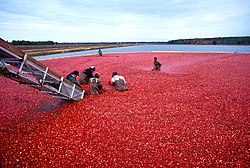Cranberry juice
Cranberry juice is the liquid juice from cranberries. Cranberry juice sold in stores usually has sugar and water added. Some have other fruit juices.
The terms cranberry juice cocktail and cranberry juice blend mean products have between 25% and 49% cranberry juice. The rest comes from different fruit juice concentrate (usually peach, grape or raspberry), also having added sugar to improve taste. Low-calorie cranberry juice products contain artificial sweeteners. Cranberry juice is tart due to its mixed content of polyphenols. Those include flavonoids, phenolic acids and anthocyanins.[1]
Although many people believe that cranberry juice helps prevent urinary tract infections, this is not proven.[2] This was determined by the Cochrane review of clinical research. The scientific panel of the European Food Safety Authority said a cause-and-effect relationship could not be established between cranberry juice and urinary tract infections.[3]
Consuming cranberry juice and nutrition
Cranberry juice sold in the USA is 86% water, 26% carbohydrates, and less than 1% fat or protein. A cup of regular (fortified) cranberry juice (248 grams or 8 ounces) has 107 calories. It has vitamin C as an ingredient to preserve freshness. Other micronutrients may be added during manufacturing.[4] Other than vitamin C and folate having more than 10% of the Daily Value, a typical serving of cranberry juice has no micronutrients in significant content.
Cranberry juice is an acidic drink with a pH of about 2.6.[5] Some cranberry juice products have large amounts of sugar used in manufacturing. This makes the drink taste better. Drinking cranberry juice may increase the risk of hyperglycemia and reduced control of blood glucose in people with diabetes or glucose intolerance.
Cranberry Juice Media
References
- ↑ "Benefits of Cranberry Juice: Is it Healthy". Healthline. 4 February 2016. Retrieved August 18, 2021.
- ↑ Jepson, R. G.; Williams, G.; Craig, J. C. (2012). "Cranberries to Prevent a Urinary Tract Infection". The Cochrane Database of Systematic Reviews. United States National Library of Medicine. 2012 (10): CD001321. doi:10.1002/14651858.CD001321.pub5. PMC 7027998. PMID 23076891.
- ↑ EFSA Panel on Dietetic Products, Nutrition and Allergies (NDA) (May 2014). "Scientific Opinion on the substantiation of a health claim related to CranMax® and reduction of the risk of urinary tract infection by inhibiting the adhesion of certain bacteria in the urinary tract pursuant to Article 14 of Regulation (EC) No 1924/20061". EFSA Journal. 12 (5). doi:10.2903/j.efsa.2014.3657. 3657.
- ↑ "Cranberry juice blend, 100% juice, bottled, with added vitamin C and calcium". FoodData Central, US Department of Agriculture. 1 April 2019. Archived from the original on 3 April 2019. Retrieved 12 January 2021.
- ↑ Reddy, Avanija; Norris, Don F.; Momeni, Stephanie S.; Waldo, Belinda; Ruby, John D. (2016-04-01). "The pH of beverages in the United States". The Journal of the American Dental Association. 147 (4): 255–263. doi:10.1016/j.adaj.2015.10.019. ISSN 0002-8177. PMC 4808596. PMID 26653863. Retrieved 2021-01-13.
